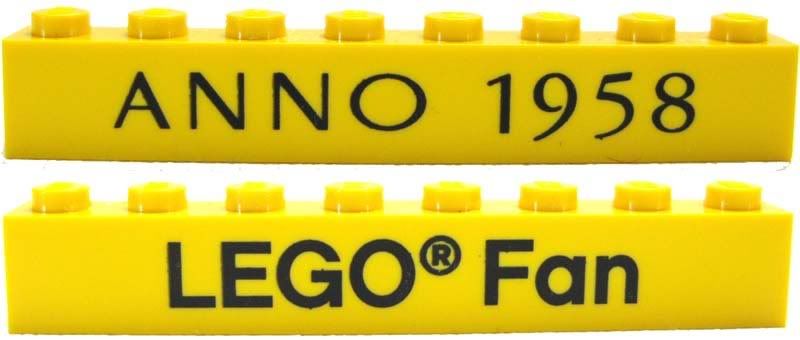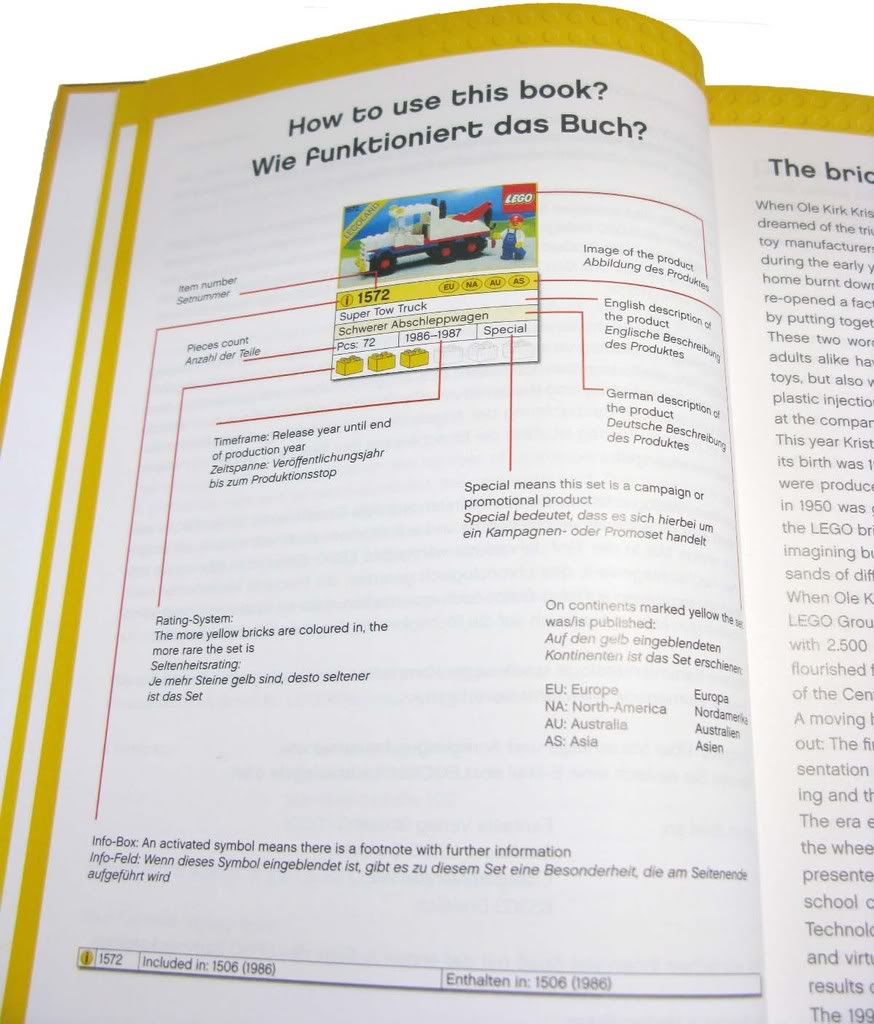 On August 13, LEGO and the Fantasia Verlag publisher officialy released the book called LEGO Collector (aka LEGO® Collector’s Guide
On August 13, LEGO and the Fantasia Verlag publisher officialy released the book called LEGO Collector (aka LEGO® Collector’s Guide ), which is a collector’s guide cataloging almost all LEGO sets from 1958-2008 in celebration of the 50th anniversay of the brick. The release features a standard edition and a premium edition (limited 3333 numbered copies) written in English and German, but both editions were released in Europe only, and there has not been news that the book will make its way to the shores of North America or the rest of the world.
), which is a collector’s guide cataloging almost all LEGO sets from 1958-2008 in celebration of the 50th anniversay of the brick. The release features a standard edition and a premium edition (limited 3333 numbered copies) written in English and German, but both editions were released in Europe only, and there has not been news that the book will make its way to the shores of North America or the rest of the world.
Currently, the book may be purchased from the publisher (which includes an unworthwhile high shipping cost) or from Bricklink for much lower prices.
UPDATE (Oct. 24): LEGO® Collector’s Guide is now available in the U.S. from the LEGO Shop online.
is now available in the U.S. from the LEGO Shop online.
While there has been a few reviews of the book on other websites, The Brothers Brick will feature a concise review covering content from cover to cover written by Jordan Schwartz with an accompanying gallery of photos.
 The LEGO Premium Collector’s Guide is a compilation of almost all LEGO products from 1958 to 2008. The only difference in terms of the book between the regular version and the premium edition is the hard cover that binds the premium edition. In addition, the premium edition comes with exclusive elements, including a standard un-glued minifigure with the 50th Anniversary logo printed on the torso, a yellow 1 x 8 brick that has printing on both sides (“ANNO 1958” and “LEGO Fan”) and a chrome gold brick with black printing (“1958-2008”). The underside of the chrome brick is tan, so it is not chrome gold all the way around similar to the chrome C-3POs.
The LEGO Premium Collector’s Guide is a compilation of almost all LEGO products from 1958 to 2008. The only difference in terms of the book between the regular version and the premium edition is the hard cover that binds the premium edition. In addition, the premium edition comes with exclusive elements, including a standard un-glued minifigure with the 50th Anniversary logo printed on the torso, a yellow 1 x 8 brick that has printing on both sides (“ANNO 1958” and “LEGO Fan”) and a chrome gold brick with black printing (“1958-2008”). The underside of the chrome brick is tan, so it is not chrome gold all the way around similar to the chrome C-3POs.
 The book’s cover measures 8.5″ x 6″, so it is a rather small book but rich with 800 pages! The actual content begins with a one-page introductory letter to the reader followed by a one-page how-to guide, showing a sample catalog entry and indicating what information is represented. Each catalog entry features a picture of the set (with rare exceptions when the picture is not available). Additional information includes the set number, availability (in Europe, North-America, Australia, and Asia), the name of the set in both German and English, the piece count, timeframe (release year until end of production year), and indication whether the set is a campaign or promotional product. What I personally find most interesting is the “rating system” featuring six yellow bricks, in which the book quotes “the more yellow bricks there are colored in, the rarer the set is.”
The book’s cover measures 8.5″ x 6″, so it is a rather small book but rich with 800 pages! The actual content begins with a one-page introductory letter to the reader followed by a one-page how-to guide, showing a sample catalog entry and indicating what information is represented. Each catalog entry features a picture of the set (with rare exceptions when the picture is not available). Additional information includes the set number, availability (in Europe, North-America, Australia, and Asia), the name of the set in both German and English, the piece count, timeframe (release year until end of production year), and indication whether the set is a campaign or promotional product. What I personally find most interesting is the “rating system” featuring six yellow bricks, in which the book quotes “the more yellow bricks there are colored in, the rarer the set is.”
 Following the how-to guide is a brief two-page history of the company and a two-page evolution of the LEGO logos. Immediately after is the catalog that composes almost the entirety of the book. Starting from year 1958 to 2008, I thought I had seen everything there is to see when it comes to LEGO products since I browse online catalogs often; I was dead wrong. There are nine products per page with close to 750 pages dedicated to the catalog, so you do the math! Following the set catalog is another very great 40-page catalog featuring key chains, which I was surprised to find. After, there is a list of service packs (no pictures, though), and lastly there is the index which lists set numbers in ascending order and includes the page and year of the set. The back of the premium guide has the Premium Collector number printed. Mine is number 2154 of 3333 copies.
Following the how-to guide is a brief two-page history of the company and a two-page evolution of the LEGO logos. Immediately after is the catalog that composes almost the entirety of the book. Starting from year 1958 to 2008, I thought I had seen everything there is to see when it comes to LEGO products since I browse online catalogs often; I was dead wrong. There are nine products per page with close to 750 pages dedicated to the catalog, so you do the math! Following the set catalog is another very great 40-page catalog featuring key chains, which I was surprised to find. After, there is a list of service packs (no pictures, though), and lastly there is the index which lists set numbers in ascending order and includes the page and year of the set. The back of the premium guide has the Premium Collector number printed. Mine is number 2154 of 3333 copies.
 Overall, this is a fantastic guide put in rather simple terms that is much more than just a catalog! If you find one, I’d recommend you snatch it, as these will probably become scarce in the coming years. If you are unable to get a premium version, get the regular one. This is truly a must-have book for LEGO fans of all ages!
Overall, this is a fantastic guide put in rather simple terms that is much more than just a catalog! If you find one, I’d recommend you snatch it, as these will probably become scarce in the coming years. If you are unable to get a premium version, get the regular one. This is truly a must-have book for LEGO fans of all ages!
As an owner of the premium edition, I’d like to add some remarks to the review as well. First, the book is as its title suggests – it is a guide and a listing of LEGO sets. This is a good item to own for someone interested in owning a reference book. For other purposes, this book may fall short on expectations, since nothing more than basic info are contained in these pages. The rarity rating is interesting to look at, but it can be highly inaccurate. The earlier sets are automatically ranked higher in rarity than recent sets, while many sought-after sets such as the original AT-AT and Black Knight’s Castle, which are Bricklink’s most wanted items in their respective categories, are ranked on par with other lesser coveted sets from the same year. The rating system seems to be mostly based on the availability of the sets, which neglects the special subjective value inherent many of the more collectable sets.
The premium copy is clearly meant for collectors, since the extra content are directed towards collecting purposes. If you are a collector, the premium edition is a great product to own, since the limited numbered edition and its unique 50th anniversary appeal is bound to make the book a sought-after product in the future.
All that said, let us know if you think the Collector’s Guide is worth getting if it becomes available in the US. The standard edition may cost $35 while the premium edition may go for $60 (prices are estimates).
[poll id=”12″]
Like this article? Tell all your friends!

















